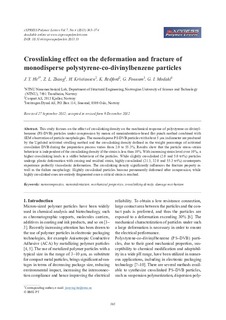Crosslinking effect on the deformation and fracture of monodisperse polystyrene-co-divinylbenzene particles
Journal article, Peer reviewed
Published version
Permanent lenke
http://hdl.handle.net/11250/2468818Utgivelsesdato
2013Metadata
Vis full innførselSamlinger
Sammendrag
This study focuses on the effect of crosslinking density on the mechanical response of polystyrene-co-divinylbenzene (PS-DVB) particles under compression by means of nanoindentation-based flat punch method combined with SEM observation of particle morphologies. The monodisperse PS-DVB particles with about 5 !m in diameter are produced by the Ugelstad activated swelling method and the crosslinking density defined as the weight percentage of activated crosslinker DVB during the preparation process varies from 2.0 to 55.3%. Results show that the particle stress–strain behaviour is independent of the crosslinking density if the strain is less than 10%. With increasing strain level over 10%, a higher crosslinking leads to a stiffer behaviour of the particles. While slightly crosslinked (2.0 and 5.0 wt%) particles undergo plastic deformation with crazing and residual strain, highly crosslinked (21.3, 32.0 and 55.3 wt%) counterparts experience perfectly viscoelastic deformation. The crosslinking density significantly influences the fracture property as well as the failure morphology. Slightly crosslinked particles become permanently deformed after compression, while highly crosslinked ones are entirely fragmented once a critical strain is reached.
